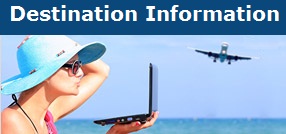Providenciales (Turks And Caicos Islands) Destination Information
Providenciales Information with Cheap Flights Booker
On or about AD 750 the first inhabitants arrived on the shores of the Turks & Caicos Islands. These were the Lucayans or, in their Arawak language, the Lukkunu cairi which has the translation of "Island Men". Their arrival in the Turks & Caicos Islands was the final stage of their long migration taking several thousand years from their original home on the banks of the Orinoco River long before the first Europeans discovered the New World or Venezuela. For those of us interested in history a visit to the Turks & Caicos Museum on the capital island of Grand Turk is essential. There among many interesting artifacts on display you will see a circa 900 year old canoe paddle in testimony to the prowess of the Lucayans as a seafaring people. One has to remember that it was to be another 700 years before Christopher Columbus arrived in the Turks and Caicos Islands to lay his claim of discovery whereas the Lucayans had traveled great distances many centuries before from South America. The Lucyans settled in many of the Turks & Caicos Islands, most notably Middle Caicos and the capital island of Grand Turk. There is also evidence of smaller settlements on the island of South Caicos. The Lucayans were a peaceful people and also skilled farmers and there still remains evidence 1000 years later of the gardens they tended and areas for their animals. The people had a meat protein diet of hutia (now extinct on the islands), iguanas and crabs. They also cultivated over 50 types of plants. Some of these plants can still be found on the islands today and some still used although likely in many different ways. The Lucayans loved to fish. They loved shellfish, particular the conch which thrives today on a commercial basis in the only commercial conch farm in the world. The Lucayans also left us some of their language as their legacy. Words such as canoe and even Caribbean are Arawak works we use today. Unlike in many previous or subsequent societies, Arawak women were highly respected inside as well as outside the household. They chiefs were venerable and they also believed in life after death (though little evidence remains to show how they dealt with their dead). By the 1520`s not one Lucayan remained alive and their unique civilization was lost to the world. The European discovery of the islands was fatal to these islands as it later proved to be in Polynesia when Capt. Cook discovered those islands several centuries later. Newly introduced diseases, enslavement and hard work in the mines of Hispaniola (now known as Haiti and the Dominican Republic) led to their extinction within just one generation. The man who many now attribute blame to the demise of the Lucayan, Christopher Columbus, set foot on Guanahani Beach on the capital island of Grand Turk on his first voyage of the discovery of the New World in 1492. A number of notable history scholars claim Guanahani Beach was the actual site of the first landing in the New World and there is even a plaque on the beach today to commemorate the event. It was there Columbus had his first encounter with the Lucayans who had a settlement close to the landing site. There is considerable evidence to establish this claim of first landfall on examination of the charts drawn by Columbus and his topographical description of the island of Providenciales that he encountered shortly on leaving Grand Turk. We even know that Columbus anchored off the west end of Providenciales close to an area now known as Malcolm Roads or often referred to now as Northwest Point. Between the years 1492 until 1706 the Turks & Caicos Islands were sparsely populated. The Bermudians came to rake the salt and then take back to Bermuda and over the years more than 1,000 ships were wrecked in the waters surrounding the Turks & Caicos Islands. Today a number of those wrecks are freely explored by scuba divers who suggest the waters of the Turks & Caicos Islands are one of the best dive locations in the entire world. Of course salt was an extremely important commodity two or three hundred years ago and in the shallow waters of the Turks & Caicos Islands salt could be "raked" in abundance. In those days salt was not only used for adding flavour but to preserve food. The Bermudians came to the islands on a regular basis and indeed salt was produced commercially in the islands until the 1960`s. A visit to Salt Cay is certainly worthwhile for the tourist or historian who can still see evidence of the salt industry very much as it was. In 1706 the Turks & Caicos Islands were captured from the Bermudians by the French and the Spanish. Bermuda was a colony of Great Britain and in 1710 the British recaptured the islands on behalf of Bermuda. In subsequent years the islands were often used as a pirate haven for pirates such as Anne Bonny and Francoise L`Olonnois who used French Cay as his pirate base for raiding passing ships. During the American War of Independence from Great Britain the islands supplied salt to General Washington`s army. In defiance of a Royal Navy blockade in 1776 Bermudian sloops ignore the blockade in order to supply the "enemy". In 1783 the French seize Grand Turk during its wars with Great Britain. The Royal Navy sent Horatio Nelson to recapture Grand Turk and even the Admiral glorious in British history for defeating the enemy fleet at the Battle of Trafalgar was unsuccessful in taking Grand Turk back for the Crown. However, the islands are later restored to Britain by the Treaty of Versailles. Many Americans loyal to the Crown (known as Loyalists) fled the American colonies during the war of independence. Many went north to Canada but others came to islands like the Turks & Caicos Islands. It was in 1789 when the Loyalist refugees first started arriving in the islands and then in 1790 the Crown granted land to the British loyalists on Providenciales, Middle Caicos, North Caicos and Parrot Cay. If you look carefully you can still see a living tribute to those Loyalist pioneers in the form of cotton trees that they brought to the islands in hope of cultivating a commercial crop. Unfortunately their efforts were unsuccessful in this regard. In 1792 Grand Turk becomes the official Port of Entry to the Turks & Caicos Islands and Customs are set up rather than in Nassau in the Bahamas. But in 1799 Britain decides in favour of Bahamian rule for the Turks & Caicos Islands which does not go down well at all with the Bermudians. Most of the inhabitants in the Turks & Caicos Islands in those days were Bermudian and start to resist rule from the Bahamas. In the war of 1812 between the United States and Great Britain settlers in the islands set up cannons at Fort George Cay (a small cay located between the island of Providenciales and North Caicos) in anticipation of attack by pirate and American ships. The war between the United States and Great Britain led to the suspension of trade and subsequently famine throughout the islands. In 1813 a large hurricane forced many of the Loyalists to leave the islands for safer havens on other British islands or in Canada. Some Loyalists moved to Grand Turk and took their slaves with them. Then in 1821 hundreds of slaves fled from the islands and escaped to freedom in Haiti. By 1834 all British Colony slaves were granted their freedom, many years before the American Civil War that resulted in freedom for the American slaves. In 1842 Bambarra on Middle Caicos was settled by survivors of a Spanish slave shipwreck called the "Gambia". In 1873 Queen Victoria grants a royal charter whereby the Turks & Caicos Islands become an independent colony and are no longer part of the Bahamas. In 1874, however, the islands were annexed to Jamaica that provided medical and technical assistance as well as substantial grants following "The Great Bahamas Hurricane" that devastated the Turks & Caicos Islands and the entire Bahamian chain. In 1898, almost 1200 hundred years since the Arawak first settled the islands, technology arrives with the first telegraph cable linking Bermuda, Grand Turk and Jamaica. In WWII the US Coast Guard installs a submarine tracking base on the island of South Caicos and in 1950 a US missile tracking station was established on Grand Turk and then subsequently closed in 1980. It was only in 1948 when the first commercial flight arrived to the islands! Many tourists arriving now to the islands comment on the lack of agriculture. In 1960 Hurricane Donna devastated all agriculture and no subsequent effort was made by the British government of the time to restore the islands ability to grow food for itself. Apart from a small hydroponics farm of the islands that produces a few tomatoes at the cooler times of the year as well as some lettuces, nothing apart from fish and conch is produced on the island. Everything has to be imported from either neighbouring islands such as the Dominican Republic but most of the food supplies are imported from the Florida and the United States. In 1962 when Jamaica gained its independence from Britain the Turks & Caicos Islands decided to remain a British Crown Colony. It remains as such even today with no real agenda for independence in the future. Also in 1962 Astronaut John Glenn first touched land on Grand Turk after his epic space flight, perhaps heralding his historic achievement out of respect for the man who set foot on the same island centuries before, Christopher Columbus. Centuries after Christopher Columbus charted the coastal waters of the island Providenciales, in 1966 Provident Ltd in exchange for 4000 acres began development on the island that later became the first real tourist destination in the Turks & Caicos Islands. Although not suitable for today`s modern jets, Provident Ltd constructed the first airstrip which Johnston`s Ltd upgraded 15 years later and which has now developed in to a modern, International airport. Provident also constructed roads on Providenciales to link the three local settlements and built a 10 room hotel called The Third Turtle Inn. In 1968 the airport opened. It was not until the early Eighties when the Club Med Turkoise resort was open that Providenciales became a serious tourist destination. The ensuing years saw the start of development along Grace Bay from Club Med to Turtle Cove, a distance of seven miles or more. Grace Bay now hosts some of the world`s top resorts and condominium developments (including the Trade Winds Condotel which is located at the very heart of Grace Bay) In 1997 the Provo Golf Club opened, reputed to be one of the best courses in the Caribbean. Today after almost 1200 years of recorded history, the Turks & Caicos Islands stand on the threshold of an exciting future boasting the fastest growing economy in the Caribbean basin coupled with strictly controlled development to protect the islands heritage as a pristine sanctuary for both the local people and tourists to enjoy for the next Millennium. The Turks & Caicos Islands are indeed Beautiful by Nature.
Call Cheap Flights Booker on 0207 096 1130 to get more tricks and trip about visiting Providenciales (Turks And Caicos Islands). Our experienced travel consultants will be more then happy to help you out with your queries and problems regarding your Cheap Cheap Flights to Providenciales (Turks And Caicos Islands).
To book your flight to Providenciales (Turks And Caicos Islands) visit Cheap Flights to Providenciales










